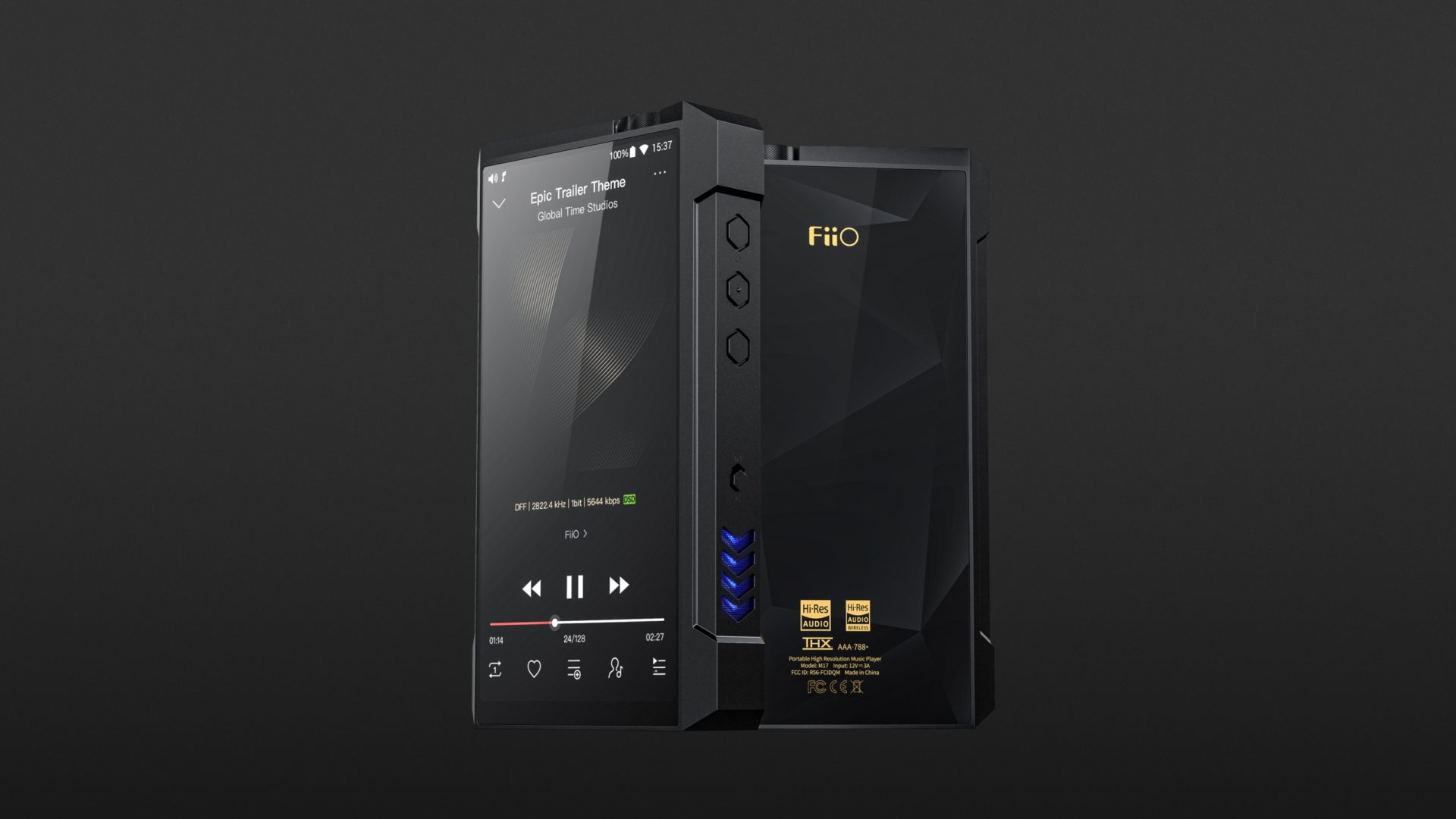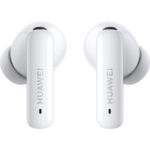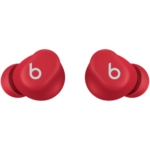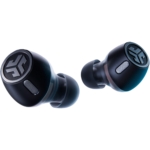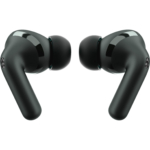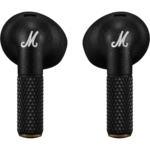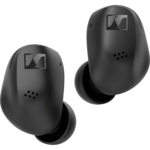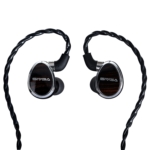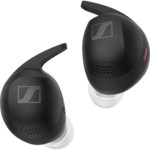With the M17, FiiO offers an exclusive premium device with opulent features. Outstanding sound thanks to dual DAC technology and the best technical components, a highly optimised power supply and a battery for long hours of mobile music and the highest manufacturing quality result in a masterpiece. And not just a portable one, the M17 also ranks alongside the highest-quality desktop devices for home use. This is where it really comes into its own, thanks to its abundant connectivity. Connected to a streaming service or a local music library; no wish remains unfulfilled. At a price of 1,799 euros, the FiiO M17 earns our special recommendation for connoisseurs and lovers of luxurious sound equipment!
Excellent sound thanks to the use of double DA converters, highly optimised power supply, a powerful battery for long hours of mobile music and technical components of the highest quality. These are the hallmarks of the recently released FiiO M17. An exclusive premium model with opulent features that represents the latest state of the art portable technology which is worthy of a special recommendation!
The Chinese manufacturer FiiO was founded in 2007 with the intention of developing high-quality portable hi-fi products. The range includes portable digital audio players (DAP), in-ear headphones and headphone amplifiers that are designed to meet high quality standards. The freshly released FiiO M17 model continues the manufacturer’s series of DAPs and confidently demonstrates the state of the art mobile technology in this field.
The times when “portable hi-fi devices” were equated with cheap goods are long gone. Today, portable players are appearing on the market that, compared to those of the past, have hardly changed in size but use high-end technology in the most compact of spaces. With the M17, FiiO introduce a real behemoth, so we took a closer look.
In practice
FiiO ships the M17 model with two packages. The first includes the DAP and its accessories, while the second package contains the DK3 stand unit. Both packages are substantial and emphasise both the size and the status of the M17.
The multifunctional DK3 dock includes the stand. It is made of solid metal and thus has the necessary stability to hold the rather heavy M17 (see below). An integrated fan with two-stage speed control is designed to keep the player cool during prolonged use. The included USB cable supplies the fan with power.
The first thing you notice when you open the M17’s classy packaging is a handy matte black folder containing an SD card reader attached to the outside, a multilingual quick-start guide, the warranty card and a protective cover for the touchscreen. Underneath are the player and the external power supply.
Appearance
At first sight, the FiiO M17 is literally stunning. The dimensions of 156.4 x 88.5 x 28 mm far exceed the common idea of a portable player, and this also applies to the weight of 610 grams. There is because the M17 consists of a CNC-milled aluminium housing that is almost completely filled with electronic components. Protection is provided by a high-quality leather cover, and there is an artfully designed metal grille embedded in the back, this is intended to serve for cooling with the fan in the stand holder and it further enhances the sophisticated appearance.
The size format is roughly equivalent to a current iPhone Max, albeit with almost three times the thickness. Like the model we already tested, the FiiO M11, the manufacturer uses its own design. Curves are dispensed with, and the focus is on the angular, bulky and rather imposing shape. The overall appearance is defined by slanted edges, a non-slip feel and the geometrically mirrored reflections on the back. Due to the device’s thickness, the manufacturer was able to install a full-screen Incell touch display with 5.9′ and 1080 × 2160 pixels at an aspect ratio of 18:9 on the front, which really benefits ease of use.
The FiiO M17 leaves nothing to be desired with its connectivity. The device offers a 3.5mm and a balanced Pentaconn headphone and line output, another balanced headphone output (2.5 mm) and a 6.3 mm headphone output, which is rather unusual for this class of device. Digital interfaces include coaxial inputs and outputs and two USB connections. The USB 3 port supports data exchange with a computer and functionality as a USB DAC. It can also be used as a USB audio output and enables the charging function. The USB 2 port serves as an audio output and as a peripheral connection (USB OTG). Furthermore, the connector for the external power supply unit and a slot for microSD cards with a capacity of up to two terabytes is located on the underside of the device.
At this point, it becomes clear that the M17 is not exclusively a portable player. On the contrary, due to its size, a number of functions and connections are available that are usually found on desktop devices.
Operation
The operating concept found on the FiiO M11 is also used here. In addition to the high-resolution, fast-reacting touchscreen, there are several haptic buttons and controls for carrying out various functions. The high-resolution precision control for fine adjustment of the output volume deserves special mention. Likewise, the volume can be adjusted via two buttons. If we add the touch screen as a variant, there are three options for volume control. Both the touchscreen and dedicated buttons can also be used for the playback functions; in the end, everyone should be able to find their preferred operation with the M17. In addition, a power/lock button, a multifunction button and a hold and battery/DC switch complete the analogue button control panel. Visually, some functions are indicated by an ingenious RGB light scheme. For example, a change in volume is indicated by a seven-colour LED circle underneath. The resolution of the audio files can also be displayed in colour. And if that is not enough, you can define your own colours or use a custom colour scheme.
The technology of the FiiO M17
As with the FiiO M11, the FiiO M17 uses a Qualcomm Snapdragon 660 SoC processor with a frequency speed of 2.2 gigahertz and eight processing cores. The internal RAM is 4GB and the internal storage space is 64GB. The WiFi, Bluetooth 5, MicroSD slot and USB audio interface are used for external communication.
Six operating modes
The FiiO M17 comes up trumps with six operating modes: Android, Pure Music, USB DAC, Bluetooth Receiving, SPDIF-RX, and AirPlay.
The Android mode allows the user to freely install any applications, including streaming services such as Qobus, Tidal or Apple Music. It can also be controlled from smart home devices. In Pure Music mode, the device uses the built-in FiiO Music app. This deactivates all services working in the background in order to offer the best possible output quality. The USB DAC mode turns the M17 into a high-quality digital-to-analogue converter that can be used both on a computer and with a home system. This allows music libraries on your computer to be played back with first-class conversion. The “Bluetooth Receiving” mode enables wireless music reception with better quality output than via a smartphone. The “SPDIF-RX” setting activates the coaxial input to decode incoming digital streams. Finally, it can be integrated with Apple products using AirPlay mode, with the M17 acting as receiver and transmitter.
D/A converter
At the heart of the M17 are two ES9038PRO D/A converters from ESS Technology Inc. The combination of two converters is said to provide the best possible sound quality, delivering detailed and finely resolved audio information across the entire frequency and dynamic range. If you look at the technical data of these converters, you will expect a lot: With a maximum resolution of 32 bit and 768 kHz as well as DSD 512, the signal-to-noise ratio is above 123 dB. The specified frequency range extends from 5 Hz to 80 kHz. The potential for MQA decoding in eightfold mode also confirms the high standard. In addition to a countless number of lossless formats, the unit obviously also plays sound-compressed files such as MP3, OGG and many others.
THX amplifier
The M17 uses a dual THX AAA-788+ headphone amplifier, which has been modified and adapted by FiiO Electronics and THX Ltd for the latest player. THX certification ensures that only components of high quality with the lowest manufacturing tolerance are used, ultimately guaranteeing high sound quality and fine dynamic gradations. In this case, high output power and the best quality were chosen to ensure operation with different headphone models.
Power supplies and runtime
The manufacturer also relies on a dual solution in this area. Two power supply units that have been optimised for the relevant applications are used. In mobile use, optimisation ensures economical consumption while at the same time providing different gain levels for accomodating a wide variety of headphone models.
The powerful lithium-polymer battery delivers a whopping 9,200 mAh and, according to the manufacturer, a runtime of up to ten hours. The complete charging time is around four and a half hours. The QC 3.0/4.0 and PD 2.0/3.0 Fast Charge formats are supported.
Streaming
The M17 uses a modern QCC5124 chip with Bluetooth 5.0. This enables the transmission and reception of a wide range of formats. In practice, the current version proved to be stable and far-reaching. On the receiving side, the formats SBC, AAC, aptX, aptX LL, aptX HD, aptX Adaptive and LDAC are supported; on the transmitting side, SBC, AAC aptX, aptX HD and LDAC. In addition to the streaming-enabled operating modes “Android” and “Pure Music”, there are also “Bluetooth Receiver” and AirPlay modes. Music can be transmitted over the airwaves via UPnP as well as via any DLNA-certified streaming client.
Sound
The neutral Funk-MTX-Monitor preamplifier was used as a playback device to allow us to make direct comparisons. Other playback devices used were a Cambridge Audio CXN V2 streamer/network player, a CD player (NAD 512) and a smartphone (Samsung Galaxy S7). Our headphone selection included models from Stax, Focal and Sennheiser. Last but not least, a Lavry DA11 served as the transducer evaluation.
The focus of our test was on the “Pure Music” mode and this was occasionally supplemented by using the Android mode. Noticeable differences were noticeable across all styles of music in terms of dynamics, spatial representation and frequency reproduction. The “Pure Music” mode, freed from all burdens, offered fine dynamics and a fantastic spatial representation that was unparalleled and was actually partly lost in the Android mode. This applied to the different frequency ranges to the same extent. Powerful and transient bass frequencies, triggered by crisp bass drums or deep metal basses, are presented in a completely relaxed manner. Just as detached from any tension, the M17 reproduces funky Stratocaster riffs à la Earth, Wind and Fire in the mid-frequency range. Guitar riffs à la AC/DC are equally rhythmically driving and precisely defined, enough to make your trouser legs flap when they are played through the speakers. And with the vocal lines of French chansonniers such as Henri Salvador, you might believe you were literally sitting opposite the singer – the voice was projected with such precision and clarity without ever seeming exaggerated. In terms of frequency, the rhythm section built up around his voice. This resulted in clearly delineated tonal structures for each acoustic instrument with subtle inherent dynamics and unparalleled transparency. Dancing rhythms on the cymbals generated bell-like overtones without any sharpness and reached up into the ultrasonic range – detached and floating. This full-bodied reproduction made music into a tangible experience. And that’s what matters in the end.
The sonic comparison with a common smartphone, the Samsung Galaxy 7, was immediately apparent and revealed such clear differences that we can simply call them different categories, insofar as they can only be poorly compared.
Technical specifications
- Ear couplingVerstärker
- Frequency response (headphones)5 - 80.000 Hz
- Impedance16 - 300 ohms
- Weight without cable610 g
What's in the box
- Brown leather case
- External power supply unit
- USB 3.0 cable
- Stand with fan
- Protective glass
- Pin for ejecting the microSD cards
Special features
- Available from: fiio.com/m17e
- for all technical data, see: fiio.com/m17_parameters




